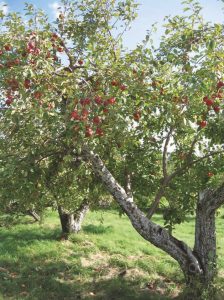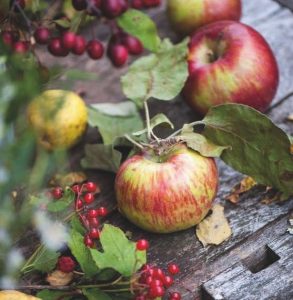The Original Fruit
Sometimes the winter seems like a bleak time, although there are, of course, things that make it worthwhile: hot chocolate, warm fires, and planting apple trees.
 DNA research shows that apples originated in Kazakhstan. Spreading across Europe, there is evidence to prove that we had wild apples in Britain until the Romans brought varieties for our sweeter taste buds.
DNA research shows that apples originated in Kazakhstan. Spreading across Europe, there is evidence to prove that we had wild apples in Britain until the Romans brought varieties for our sweeter taste buds.
When to plant
Fruit trees may not look particularly attractive during the winter months but this is actually the best time to plant bare root trees (as long as the ground is not frozen). Potted trees can be planted year round. During the ‘bare root season’ fruit treesare dormant and as such they experience less shock during transplanting. The roots will grow throughout the winter months leading to good growth during the tree’s first season.
Selecting a site
When selecting a planting site for your fruit trees, sun and soil are the most important considerations. Fruit trees need sun – about six hours a day – in order to remain healthy and produce fruit. Fruit trees also need well-drained soil. When planting the soil should not be frozen and it should not be waterlogged. The majority of apples will require a pollinating partner but there are a number of varieties, which are self-fertile.
Grow
 Your tree will need to be staked and secured with a suitable tree tie, which can be adjusted as the tree grows. Depending on the rootstock of the tree and it’s location staking is required for the smaller rootstock for life, and for the more Semi-vigorous rootstock for the first five years.
Your tree will need to be staked and secured with a suitable tree tie, which can be adjusted as the tree grows. Depending on the rootstock of the tree and it’s location staking is required for the smaller rootstock for life, and for the more Semi-vigorous rootstock for the first five years.
Care
It is a good idea to feed the tree during Autumn or spring with a suitable feed.Whilst you may not want to remove apples, it can be a good idea to thin them out, to achieve better quality and tastier fruit. Protect from Codling Moth in Spring by hanging a codling moth trap close to the trees. This will prevent “maggoty” fruit.
Choosing the tree for you
Whether you have a large or small garden, there’s an apple tree for you, and understanding the different rootstocks is the key to choosing the right specimen. A rootstock determines the trees’ suitability for training or growing, so you’ll need to bear this in mind if you’re thinking of growing your tree in a particular way.
Which rootstock?
Here are the most common rootstock options:
- M27 Very dwarfing: Ideal for step-overs, vertical cordons, patio trees
- M9 Dwarfing: For oblique cordons, step-overs, large potted trees
- M26 Semi-dwarfing: For bushes, half standards (best suited to lighter, richer soils)
- MM106 Semi-vigorous: for double cordons, trained trees, bushes, half standards
- M25 Very vigorous: Full Standards.
Why heritage?
 By planting heritage trees we can preserve them for future generations, so the beauty and wonderful flavour can be enjoyed by all.
By planting heritage trees we can preserve them for future generations, so the beauty and wonderful flavour can be enjoyed by all.
Health-giving properties
A recent survey revealed that many older varieties of apple are far more healthy than modern supermarket equivalents. A group of researchers tested 66 apple cultivars from the National Fruit Collection at Brogdale, Faversham and found out that many of the heritage varieties had far higher levels of nutrients than newer cultivated apples. It seems that many health-giving properties have been gradually bred out of modern cultivars, as producers focus on appearance and storage.
Older varieties contain higher levels of phloridzin, a chemical hat helps regulate blood sugar and can reduce the risk of type 2 diabetes.
The National Fruit Collection
Brogdale currently conserves over 2,300 varieties of apples alone and the team at GROW AT BROGDALE (the on-site fruit tree nursery) graft several thousand trees every year, with a real focus on promoting rare and heritage varieties. With the grafting material being supplied from the National Fruit Collection each tree is in essence, a little piece of history! For more information or to place an order for fruit trees visit www.brogdaleonline.co.uk (01795 531888)
Posted in: Gardens
